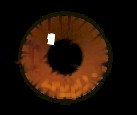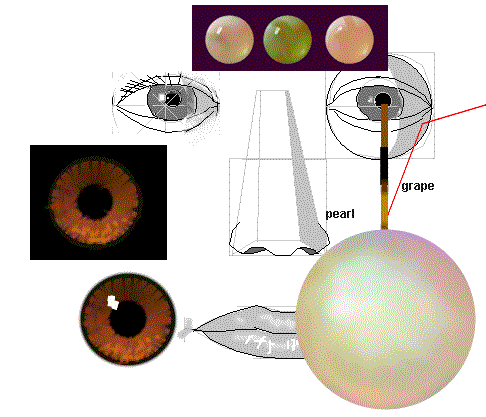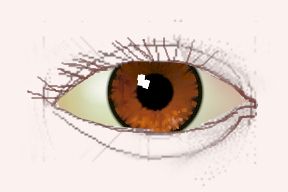|
The eye is a ball with the iris (dark part) forming a slight projection like a boss.
The pupil is not a color but a dark shadow, a hole that allows light into the eye.
An attribute of the eye is the that it is translucent. This can lead to the following paradox: when the light strikes the iris at an angle the highlight appears to be surrounded by dark even though being round, that side is facing the light.
There are two layers to the outer eye. There is the cornea, and the lens.
Light might very easily pass through the cornea, and reflect off the lens
causing a hightlight at odd locations on the cornea. Both these stuctures bend light to some extent; the lens obviously bending light more than
the cornea. A hightlight on the cornea should show up on the
opposite side of the cornea as a reflected hightlight just as it does in
glass.

The light that is seen in the iris of the eye opposite the highlight is
transmitted light, which is seen also in a glass or bottle of wine, or any
container of transparent liquid. It works the same with a grape. The iris of
an eye is likewise a container of transparent liquid. Light passes through it
and reflects off the inside of the back of it, 180 degrees opposite the entry
point. The highlight itself is the reflection of the light source from the
moist outer surface of the eye. Of course this only occurs when the eye is in
the light.
So the side opposite to the highlight often seems lit up, although it is in shadow.
The proper rendering of this effect gives the eye an aqueous and luminous quality, which is not available in any other way. Indeed it is possible to introduce this effect deliberately by changing the position of the highlight and thus transforming a dull eye into a live one. Often I introduce highlights into the eyes even when it is optically impossible, or when the light source was not even reaching the eye. I consider the employment of such a device to be a legitimate conceit and a method sometimes necessary in portraiture. The fact that, scientifically, the angle is 180 degrees is dependent on the eye being spherical. Unfortunately there are two spheres that contain the surface of the eye which complicates the angle of reflection even more.

You'd turn a cherry into a grape by adding the transmitted light to
the side opposite the light's entry point. A grape is translucent; a cherry
is not. Light travels through a grape.
You'd also diffuse the highlight a bit more to indicate a less glossy
surface. The highlight is the reflection of the light source on the surface,
and the degree to which it is diffused indicates the texture of the surface.
You might contrast edgy polished metal one the one extreme with soft velvet on the other, for example.

So there we are, mere prisoners of our dermis but with an intelligent sparkle in our eye!
NOTE: Eye conditions and their connection with painting is no where better demonstrated than in Peter Bueughel's 'The Parable of the Blind' where the five beggars are afflicted with five separate but identifable eye diseases.
|